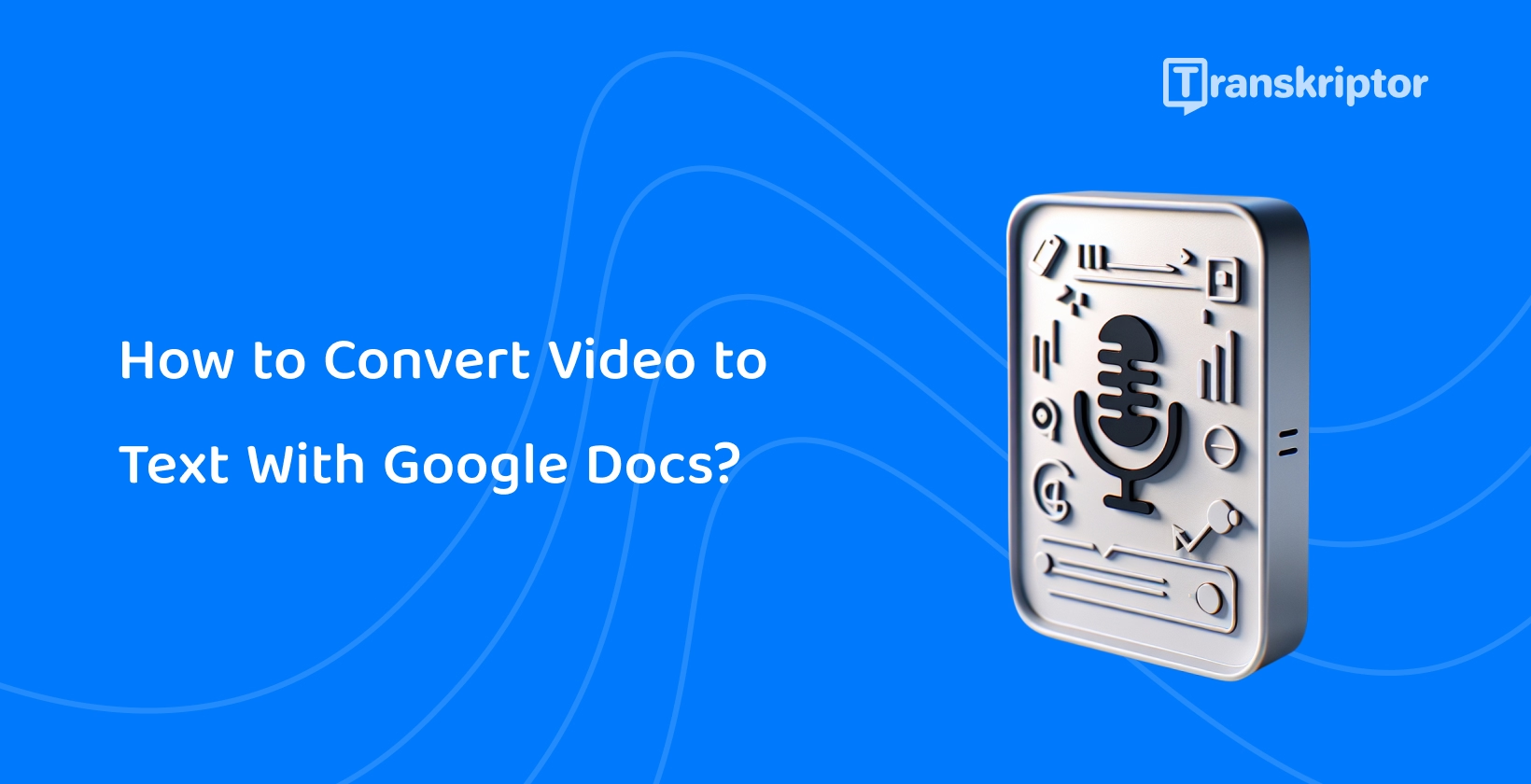Having clear instructions significantly streamlines the transcription workflow while the process seems straightforward. The 6 steps to convert video to text with Google Docs.
- Prepare the Video: Check video accessibility and clarity. Improve audio if needed, consider length, familiarize with content, and reduce background noise.
- Open Google Docs: Log in to Google Docs, start a new document or open an existing one, preparing your workspace for transcription.
- Enable Voice Typing: Activate the voice typing tool from the "Tools" menu to prepare for dictating the video content into text.
- Play the Video: Begin playing your video with the voice typing feature active, adjusting volume for clear audio pickup by the microphone.
- Editing and Review: Turn off voice typing after transcription, review the document for errors, and make necessary corrections and formatting.
- Save and Use the Transcription: Google Docs auto-saves changes; download in preferred formats if needed, and share directly from the platform for collaboration.
Step 1: Prepare the Video
Users should ensure their video file is readily accessible and playable on their computer to convert video to text with Google Docs. It's crucial to have a clear and audible audio track within the video, as this significantly enhances the accuracy of the transcription process. Users are able to improve the audio quality through basic editing tools or software before proceeding if necessary.
Additionally, editors should consider the video length they intend to transcribe. Longer videos usually require more time for transcription, so it's advisable to plan accordingly and allocate sufficient time for the process.
Furthermore, ensuring the video is free from interruptions or background noise will facilitate a smoother transcription process. Users should consider eliminating or minimizing distractions that affect the clarity of the audio and subsequently impact the accuracy of the transcription.
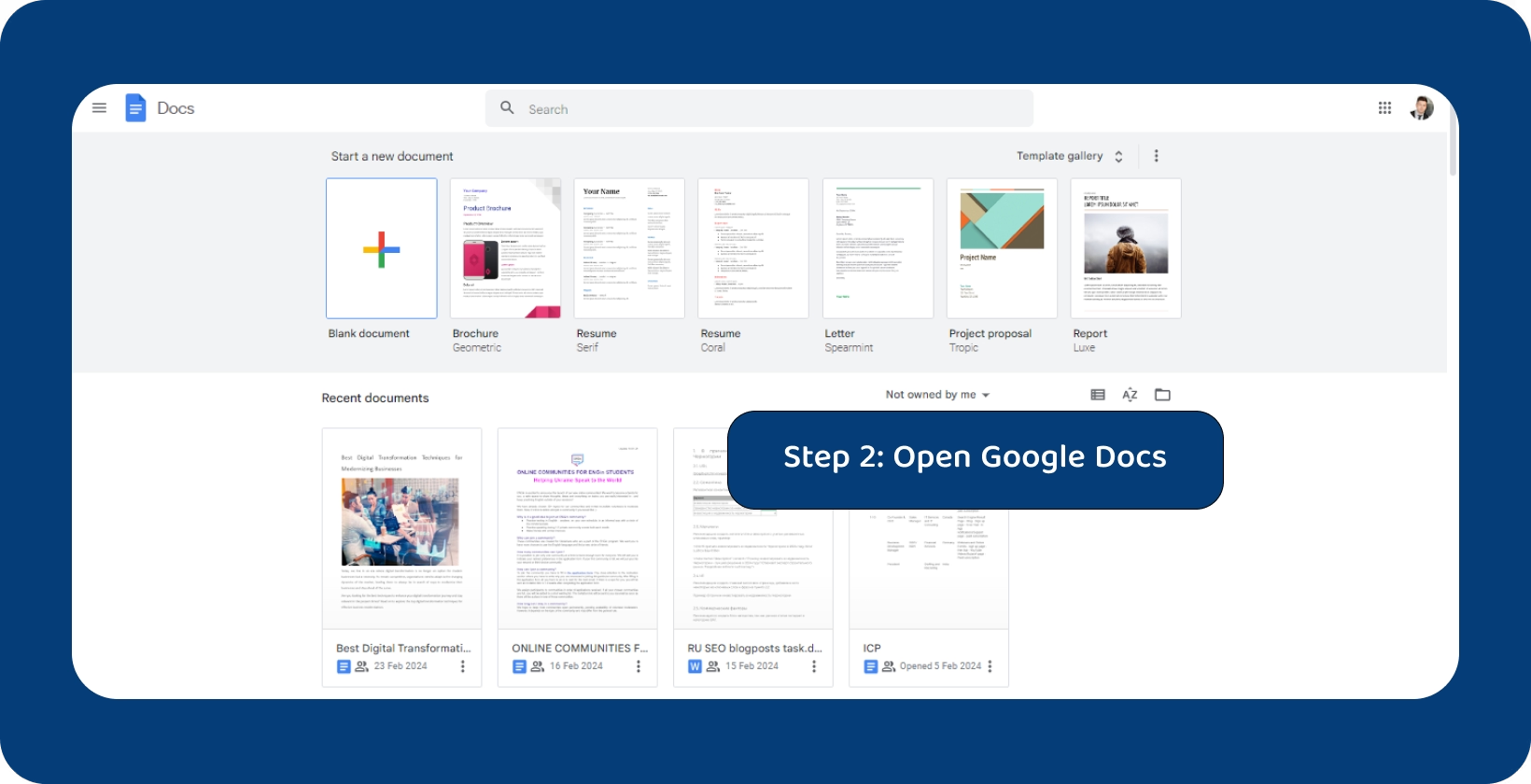
Step 2: Open Google Docs
Users need to open Google Docs to begin the transcription process. They should navigate to the Google Docs website using their preferred web browser. Next, they are able to sign in with their Google account credentials.
Editors have to initiate a new document by clicking on the "+" icon, which represents a blank document. Alternatively, they are able to open one from their Google Drive if they prefer to work within an existing document.
Opening Google Docs allows users to start transcribing their video content. The platform offers a user-friendly interface with various features to facilitate transcription, such as text formatting options and collaboration tools.
Users are ready to import the video content for transcription once they have accessed Google Docs.
Additionally, users are able to discover it is advantageous to use Transkriptor , which is among the best video to text softwares , for advanced transcription capabilities instead of converting video to text with Google Docs. Transkriptor streamlines the transcription process with its high quality
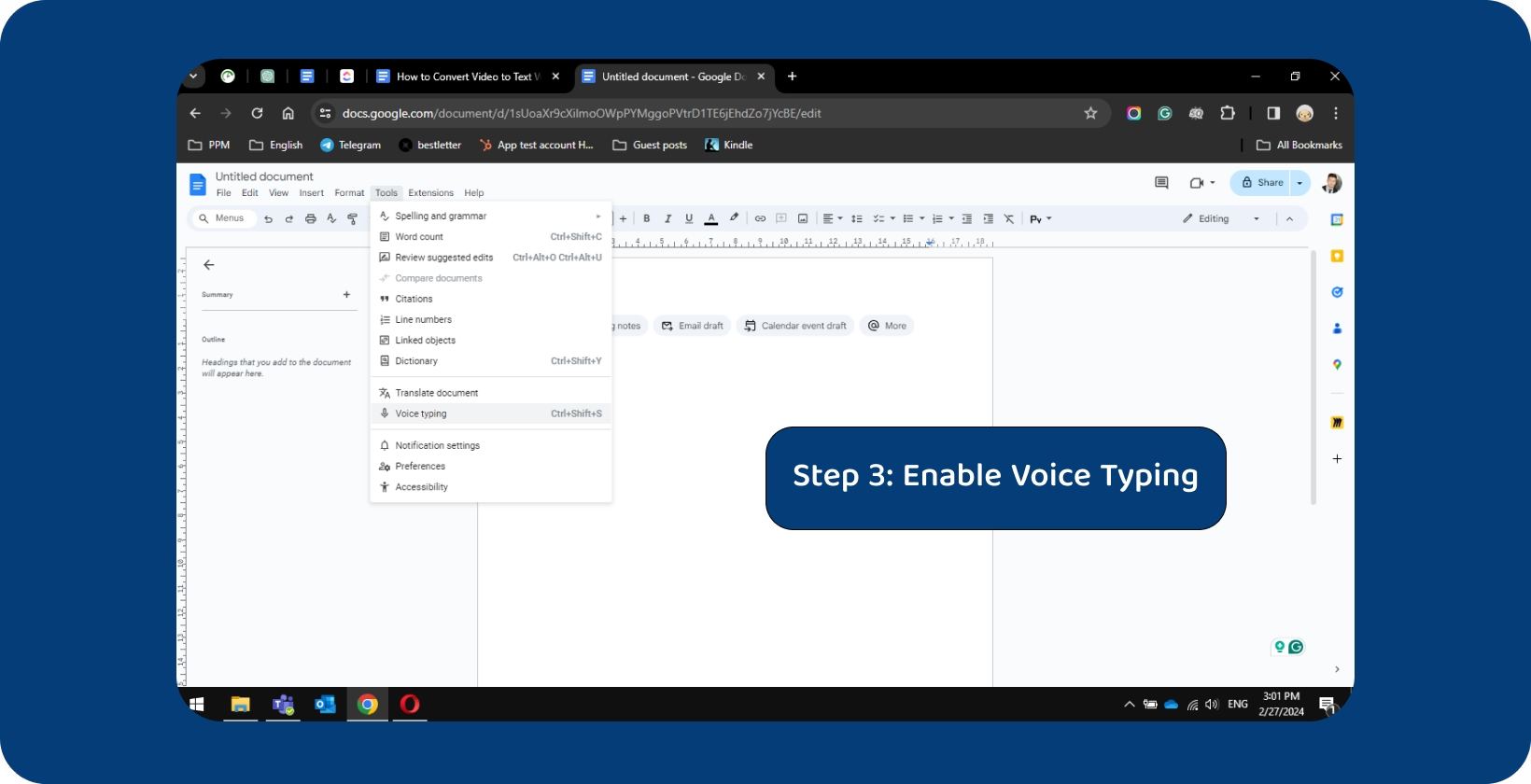
Step 3: Enable Voice Typing
Users should access the tool conveniently from the platform's menu bar to enable voice typing in Google Docs. They have to seamlessly activate voice typing functionality by clicking " Tools " in the menu bar.
Next, editors should select "Voice typing" from the dropdown menu that appears. This action prompts Google Docs to initiate the voice typing feature, enabling them to transcribe spoken content directly into the document.
Users will notice a microphone icon appearing on the left side of their document interface once voice typing is enabled. This icon serves as a visual indicator that voice typing is active and ready for use.
Users are able to begin speaking the content they wish to transcribe, ensuring clarity and enunciation for accurate text transcription . Google Docs will convert the spoken words into text in real time, displaying them directly within the document.
Step 4: Play the Video
Users should click the microphone icon within their Google Doc interface to activate the voice typing feature. This ensures that Google Docs is ready to transcribe the spoken content as the video plays.
Editors should proceed to play the video once voice typing is enabled. It's essential to ensure the video's audio is audible to the microphone to facilitate accurate transcription. They need to adjust the volume levels of their speakers or headphones accordingly to achieve optimal audio clarity.
Users are able to convert video to text with Google Docs in real time as the video plays. They should observe the transcription progress directly within the document, with the text appearing as they speak.
Users have the flexibility to pause, rewind, or fast-forward the video as needed to ensure accurate transcription during playback. This allows them to revisit video sections or clarify unclear audio segments to improve transcription accuracy.
Step 5: Editing and Review
Users should click the microphone icon within Google Docs to deactivate the voice typing feature after completing the video transcription. This signifies the transcription process's end and prevents unintended text input.
Users should pay close attention to any words or phrases that have been inaccurately transcribed during the editing and review phase. They should compare the transcribed text with the original video content to ensure accuracy and clarity.
They should consider formatting the transcribed text appropriately to enhance readability. This includes adjusting spacing, punctuation, and paragraph structure to create a polished final document.
Additionally, users should be careful of contextual nuances or speaker attributions requiring clarification within the transcribed text. Adding annotations or speaker labels will help provide context and improve comprehension for readers.
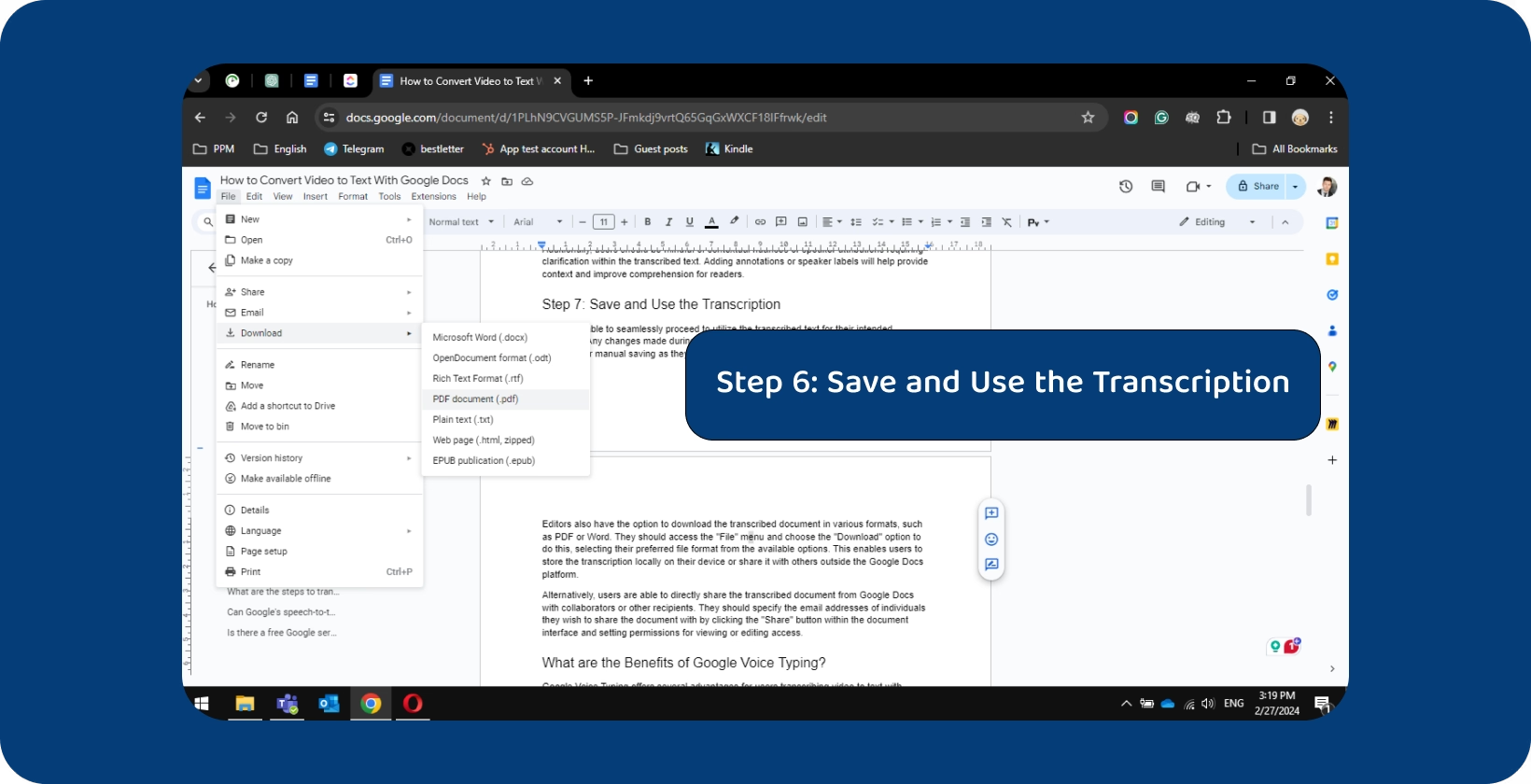
Step 6: Save and Use the Transcription
Any changes made during the editing process are automatically preserved without the need for manual saving as they navigate through Google Docs.
Editors also have the option to download the transcribed document in various formats, such as PDF or Word . They should access the "File" menu and choose the "Download" option to do this, selecting their preferred file format from the available options. This enables users to store the transcription locally on their device or share it with others outside the Google Docs platform.
Alternatively, users are able to directly share the transcribed document from Google Docs with collaborators or other recipients. They should specify the email addresses of individuals they wish to share the document with by clicking the "Share" button within the document interface and setting permissions for viewing or editing access.
What are the Benefits of Google Voice Typing?
Google Voice Typing offers several advantages for users transcribing video to text with Google Docs:
- Efficiency: Voice typing significantly speeds up the transcription process compared to manual typing, allowing users to transcribe content more quickly and efficiently.
- Hands-free operation: Editors transcribe content without needing to type manually, enabling a hands-free transcription experience that is particularly beneficial for individuals with mobility issues or those multitasking.
- Accuracy: Google Voice Typing generally provides accurate transcriptions, especially with clear audio. This helps reduce the need for extensive editing and review after transcription.
- Real-time transcription: Voice typing transcribes spoken content into text in real time, providing immediate feedback and allowing users to monitor the transcription progress as they talk.
- Convenience: Voice typing eliminates the need for specialized transcription software or additional hardware, as it is seamlessly integrated into Google Docs and accessible with just a few clicks.
- Accessibility: Voice typing enhances accessibility by enabling individuals with visual or motor impairments to create written content more easily.
- Multilingual support: Google Voice Typing supports multiple languages, allowing users to transcribe content in their preferred language without requiring manual translation.
Overall, Google Voice Typing offers users a convenient, efficient, and accessible solution for transcribing video to text with Google Docs, making the transcription process more manageable and accessible to a broader audience.
What are the Drawbacks of Google Voice Typing?
Users should also be aware of the limitations and potential drawbacks of Google Voice Typing:
- Accuracy issues: Google Voice Typing struggles with accurately transcribing certain accents, dialects, or technical terms, leading to potential errors in the transcription.
- Background noise: Background noise significantly impacts the accuracy of voice typing, making it challenging to transcribe content accurately in noisy environments or with poor audio quality.
- Limited language support: The accuracy and performance vary depending on the language, with some languages receiving better support than others.
- Lack of context: Voice typing struggles to accurately transcribe content that lacks clear context or contains ambiguous language, leading to inaccuracies or misunderstandings.
- Requires Internet connection: Voice typing relies on an Internet connection to function, meaning users experience disruptions or delays in transcription if they lose connectivity.
- Privacy concerns: Users should be mindful of potential privacy implications when using voice typing, as the audio input is processed by Google's servers for transcription, raising potential concerns about data security and privacy.
- Limited editing features: Users find more robust editing features lacking than dedicated transcription software like Transkriptor, potentially requiring additional time and effort for post-transcription editing and formatting.
Despite these drawbacks, Google Voice Typing remains a valuable tool for transcription tasks within Google Docs, offering convenience and efficiency for many users.
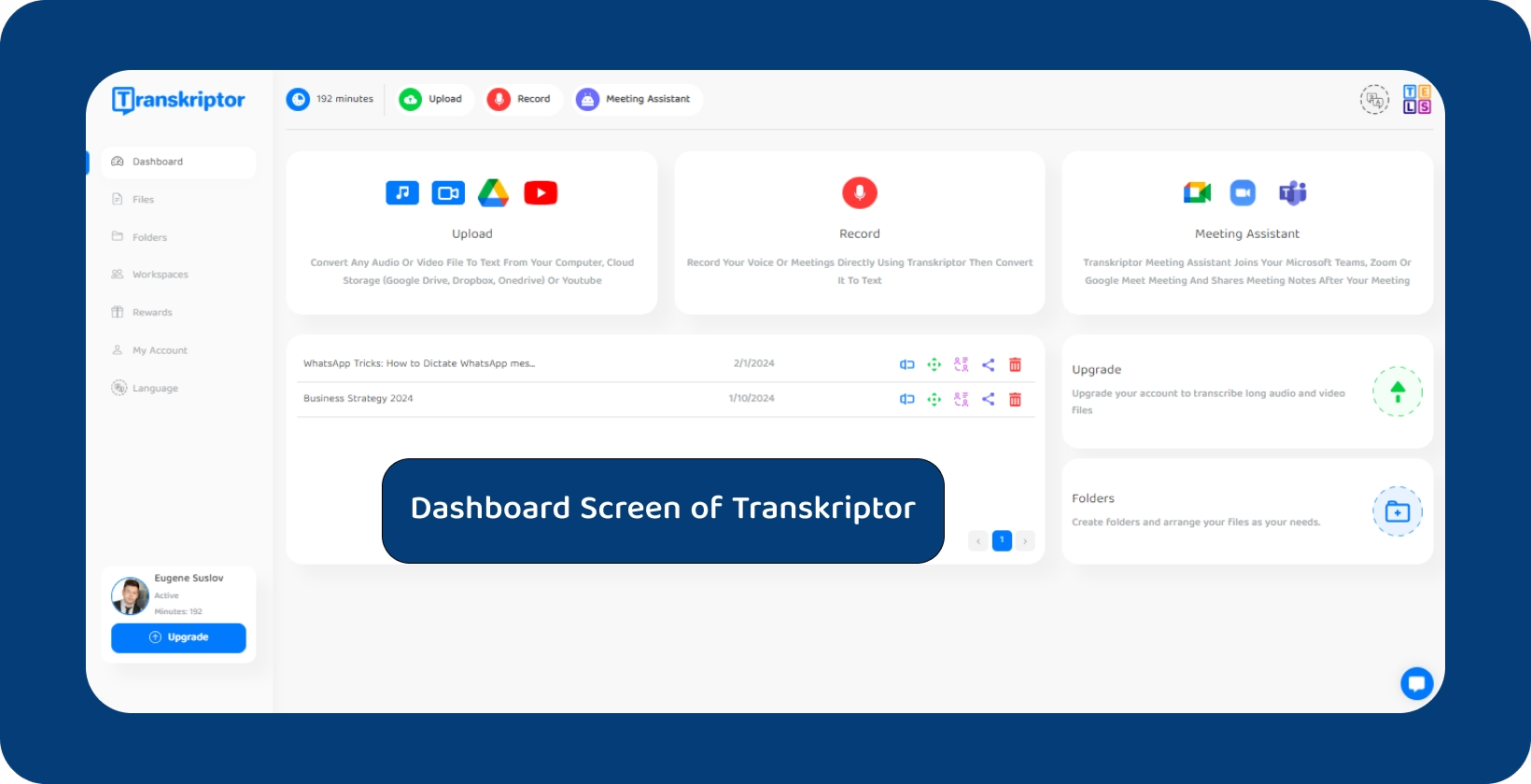
How to Get More Accurate Transcriptions with Transkriptor?
Users should leverage Transkriptor , an AI-powered assistant designed explicitly to generate accurate transcriptions efficiently and enhance transcription accuracy. They are able to streamline their transcription workflow and improve overall productivity with it.
One notable feature of Transkriptor is its ability to join, record, and transcribe online meetings automatically. This eliminates manual note-taking during meetings, allowing team members to actively participate in discussions without worrying about capturing every detail.
Additionally, users are able to engage in conversational interactions with Transkriptor's AI assistant to obtain instant responses to queries about conversations, videos, or voice recordings. This eliminates the need to sift through lengthy texts or audio recordings, providing quick access to relevant information.
Transkriptor supports transcription in over 100 languages, enabling users to translate transcripts effortlessly and create written content in multiple languages with just a click. This feature is handy for interpreting recordings in foreign languages and facilitating multilingual collaboration.
Transkriptor simplifies the transcription process by supporting various audio and video file formats and offering easy access via mobile apps, browser extensions, and virtual meeting integrations with platforms like Zoom, Microsoft Teams, and Google Meet.
Editors are able to export transcripts in various formats, such as plain text or subtitle files, ensuring compatibility with different platforms and applications. Additionally, Transkriptor's advanced text editor allows users to make corrections and adjustments to transcripts easily.
Ready to experience seamless transcription with Transkriptor? Sign up now for a free trial and revolutionize how you convert video to text with Google Docs!
